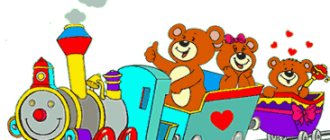Summary of a communication lesson for children in the preparatory group
Summary of a lesson on communication for children of senior preschool age
Summary of a communication lesson on the topic: retelling of the Russian folk tale “Fear has big eyes” (preparatory group).
Author: Elizarova Irina Stanislavovna, teacher, MB pre-school educational institution CRR DS “Zvezdochka”, Kondopoga Program content: 1. Introduce children to the content of a Russian folk tale. Bring to children’s understanding the double meaning of the fairy tale’s title: “Fear has big eyes.” To help understand the presence of humor in the actions of the characters. Continue learning to understand subject-schematic models based on the content of the work. To develop the ability to independently schematically convey the meaning of a proverb used in a fairy tale. 2. Continue teaching children to retell the content of a fairy tale coherently, consistently, expressively, emotionally and grammatically correctly (using models). Practice the formation of nouns with exaggeration suffixes (bear, wolf, cat). Improve the ability to express your thoughts on the topic proposed by the teacher. 3. Develop the ability to convey emotional states using facial expressions. Develop attention, memory, logical thinking. 4. To develop in children the ability to evaluate the retelling of a fairy tale by their peers. Preliminary work: talking with children about fear, drawing “My Fear,” drawing up schematic models for proverbs. Materials and equipment: book, schematic models, apple with the emotion “Fear”, sheets of paper and pencils (according to the number of children). Methodological techniques: verbal: questions to children, children’s answers, teacher’s generalization, artistic expression, reading a fairy tale with the conveyance of the emotional state of the characters, children’s retellings (in parts, in a chain), evaluation of the retelling, encouraging children;
visual: visual-schematic models for the content of a fairy tale; practical: exercise “Convey an emotion”, physical education lesson, drawing up a schematic model for a proverb. Progress of the lesson:
1. Children are asked to form a circle. “Guys, imagine that you are frowning like an autumn cloud (eyebrows knitted, eyes from under your forehead). - And now you are a person who is angry, how can you portray it? (displeased face). - Now smile like the sun smiles (there is a smile on your face) - Show how scared the hare is when he sees a wolf. You opened your eyes wide, some opened your mouth. Exactly, it’s clear that the hare was scared. - Guys, what is fear? (children’s answers and generalization of answers: fear is when someone is afraid of something). - What can you be afraid of? (children's answers: darkness, a stranger, thunder, a fairy-tale creature, etc.). - Guys, how can you get rid of fear? (children's answers). - And you and I know the “drive away”, with the help of which you can drive away fear. “Fear, horror, horror story. Rush, scurry, scurry! Turn into laughter, laughter, laughter! (performed with movements, 2 times) - Guys, have you ever had such cases when you were afraid of something that you could not have been afraid of, which in fact did not happen? (children's hypothetical answers). — I want to introduce you to a fairy tale where exactly such a story happened to the main characters, where they were afraid of something they shouldn’t be afraid of (children are invited to go to the tables). 2. Listen carefully so you can answer the questions later. Russian folk tale “Fear has big eyes” (reading a fairy tale). 3. Conversation on the content of the fairy tale. Questions: - What is the name of this fairy tale? (children's answers). - What are the names of the grandmother, granddaughter, chicken and mouse in the fairy tale? (children’s answers - water carriers). - Why do you think they are named like that? What two words did this word come from? (children's answers: carry water). - What kind of buckets did the water carriers have? (children's answers) - the teacher sets up models and uses his voice to highlight: the grandmother's - large (in a deep voice), the granddaughter's - smaller (in a normal voice), the chicken's - even smaller (in a thin voice), with which the buckets were compared: the chicken's - with a cucumber; the mouse’s is small, tiny (squeak) the size of a thimble. -Where did our water carriers get their water from? (children's answers: grandmother from a well; granddaughter from a log (a log is a thick log, the middle of which is hollowed out and filled with water; a chicken from a puddle; a mouse from a pig's hoof) - the teacher points to the models. - When they carried the water, how did it splash? (children's answers: for the grandmother - three-e-x, ple-e-h; for the granddaughter - three, plekh; for the chicken - three-three, plekh-plekh; for the mouse - three-three-three, plekh-plekh- plekh) - the teacher shows on the models. - Who seemed to be the heroes of the fairy tale? (children's answers: to the grandmother - a bear, as she spoke about him with fear - a bear - show what kind of eyes they had; to the granddaughter - a terrible wolf, what can you call a big strong wolf - a wolf; a hen - a fox; a mouse - a cat, a cat, show the mouse; a hare - four hunters, and all with dogs) _ what really happened? (children’s answers and a generalization of the children’s answers: all the heroes of the fairy tale were scared, and they themselves even they didn’t know what it really was.) -Could it be that we get scared and our eyes become very big from fear? Yes, that happens too. Sometimes you get so scared that your eyes actually become big. - What words does the fairy tale end with? (children's answers: fear has big eyes: what is not there, they see). - How do you understand these words? (children's answers). - What do you guys think, could the heroes of the fairy tale, after what happened to them, laugh at themselves? (children’s answers and generalization of answers: Yes, they were scared, something they didn’t need to be afraid of. (convey the humor of the fairy tale to the children). 4. Physical education. “Let’s go softly, like fox cubs. And like a bear, a bear. And like a gray wolf, little wolf. And the little bunny is a coward. So the wolf curled up into a ball, Because he was chilled. The ray touched the bunny, The bunny stretched sweetly" (done with movements, 2-3 times) 5. Repeated reading with a focus on retelling (the teacher reads a fairy tale, using emotions). - Guys, when you retell the story, don’t forget to tell about the water-carriers. where they went, what buckets they had, where they got the water from, then how they got scared and where they ran, who imagined it, and how the fairy tale ended (the teacher displays the models - sequence of the content of the fairy tale). 7. Evaluation of retellings (based on questions from the teacher, if the children find it difficult) - What did you like best about the retelling and why? — Who managed to convey the feeling of fear? 8. What does a fairy tale teach us? (children's answers) The teacher invites the children to draw a schematic picture for the last phrase - the proverb: “Fear has big eyes - what they don’t see, they see” (children’s options are considered, the teacher can offer his own version). 9. Result: questions for children: -What fairy tale did we meet? — What helped you remember the fairy tale? — What did you like about the lesson? - Who thinks that he coped with the retelling of the fairy tale today? — What was difficult? The teacher gives a general assessment of the lesson. P.S. If anyone is interested in the summary, I can send you visual and schematic models of the content of the tale.
We recommend watching:
Notes on educational activities for children of the senior group Notes on literacy lessons in the preparatory group Notes on FEMP in the preparatory group. Numbers from 1-8. Solving the simplest problems Plan - outline of GCD in the preparatory group for school
Similar articles:
Summary of GCD in the preparatory group on the topic: Professions
Lesson notes for the preparatory group. My family
Lesson notes for the preparatory group. Primitive people
Lesson notes for the preparatory group. Tolerance
Lesson summary for kindergarten on the topic “Human Rights”. Preparatory group
Summary of educational activities on social and communicative development in the preparatory school group
GCD on social and communicative development in the senior group
Topic: "Magical Journey"
Target:
development of effective communication skills, training in mutual understanding skills, verbalization of one’s feelings and thoughts.
Tasks:
- increase self-esteem, gain a sense of confidence;
- develop empathy, empathy, teach how to work in pairs and groups;
- develop speech and creative thinking;
- develop communication skills, listening skills, expressing your point of view;
- cultivate goodwill.
Equipment:
5 plates with the names of the islands: “Island of Crooked Mirrors”, “Enchanted Island”, “Island of Giants”, “Island of Parrots”, “Island of the Evil Wizard”. Each sign has a task attached to it, a black piece of paper, a mirror
GCD move:
— Guys, did you say hello to each other this morning? Now I suggest you say hello in a special way.
Instructions.
You need to turn to the one standing on the right, call him affectionately by name and say that you are glad to see him. He, in turn, turns to his neighbor on the right and does the same, and so on, until the greeting reaches the leader.
Note
. A helium-filled balloon flies into the room, with a letter and a map attached to it on a string.
- Oh, guys, what is this? Look, there is something attached to the balloon. Look - the message. It is addressed to friendly and kind guys. It says: “Hello guys! Buratino writes to you. I turn to friendly and kind children for help. My friends and I were bewitched by an evil wizard. He took us far, far away, far away, to an unfamiliar island, in order to make us as evil as himself. While we were flying there, I managed to draw a map that you can use to get to us. Help! Save us!
Guys, what do you think, did he write this to us? Are we friendly and kind? Can we help him and his friends? Then let's go in search of Pinocchio and his friends and help them?
To get to the Island of the Evil Wizard, look at how long a path we have to go. Let's fly in a hot air balloon, hold on to its long rope. Are you ready guys? Well, shall we go then?
- So we ended up on the first island. It's called "The Island of Crooked Mirrors." Guys, look, there is a message for us. It says here that before we go further, we need to complete a task.
Island of Crooked Mirrors
Instructions
: the teacher says: “Just imagine: you wake up in the morning, go into the bathroom, look in the mirror, and it repeats all your movements in reverse: you raise your hand, and it lowers it; you turn your head to the left, and it turns to the right; you close one eye, and it closes the other. Let's play with these mirrors.
Break into pairs. Let one of you be a person, and the other a stubborn mirror. Then you will switch roles."
First, the teacher helps to play, then the children do everything on their own.
- Everything worked out! Well done boys! We set off further (an audio recording of “the sound of the wind” sounds. The children “fly up” to the “Enchanted Island”).
"Enchanted Island"
— Guys, we ended up on the Enchanted Island. Evil fairy tale characters live here. (remember names) They do not like to be disturbed and walked on their territory. What do you think needs to be done to continue the journey? We need to cheer them up!
Instructions
: Please sit in one big circle. Everyone look at me to see what I'm doing. I try to give my face a special expression, like this. (Fix some expression on your face for a few seconds. Slowly turn your head so that all children have the opportunity to see the expression on your face.)
And then it will be like this. I turn to my neighbor on the left so he can get a better look at my expression. He must exactly repeat this expression on his face. As soon as he succeeds, he must slowly turn his head to the left, while changing his facial expression to a new one, which he “transfers” to his neighbor on the left. Everyone else does the same. First, we exactly repeat the facial expression of the neighbor on the right, then we come up with our own facial expression and “transfer” it to the neighbor on the left. Facial expressions can be comical or threatening, scary or funny.
Now, let's take a ball and draw smiling faces
- Look, guys, did we manage to make the heroes good? (Children show balloons to each other.) Well done, we did it here too! We flew on (the sound of the wind sounds. The children “fly” to Parrot Island).
"Parrot Island"
Target
: develop self-confidence.
- Guys, we ended up on Parrot Island. Parrots love to repeat people's words, praise themselves and brag. Here's a new test.
Instructions
: passing a mirror to each other, each participant in turn needs to imagine that he is a parrot and loudly praise himself. Then brag in front of the mirror about some of your qualities, skills, abilities, talk about your strengths - about what you love or value in yourself.
- Guys, we’ll fly to the next island on a cloud!
Relaxation
Note.
There is a white sheet spread on the floor, covered with cotton wool around the edges.
— Guys, how do you imagine a cloud? Guys, descend on a white airy cloud.
Note
. Quiet, calm music plays in the background.
- Sit comfortably, close your eyes. Take a deep breath and exhale... Once again... And again... inhale, exhale. Imagine that you have landed on a white fluffy cloud, as if someone had built a soft mountain of plump pillows. Feel how your legs and back are comfortably positioned on this large cloud-pillow. Now you are going on a journey. The cloud slowly rises into the blue sky. Feel the wind blowing over your face. Here, high in the sky, everything is calm and quiet. You float past the gentle sun, which touches you with its warm rays. It decided to play a little. The sun tickles your nose, eyes, mouth, ears. Bask yourself in its rays. Feel how it hides in your hair. Meanwhile, the cloud carried you further. Smile goodbye to the sun and wave your hand. Slowly open your eyes, stretch, look around... Well, here we are. Let's get off the cloud and thank it for giving us such a good ride. Stretch again, straighten up and feel energetic, fresh and attentive again.
Note
. The presenter takes the children to the island of the Evil Wizard.
- And so we ended up on the last island - this is the island of the Evil Wizard. and his friends. We need to save them.
- Guys, Pinocchio and his friends can get out of here. But an evil wizard painted the flying carpet with black paint, and now it cannot fly. We will break the evil spell if we return bright colors to the magic flying carpet.
The presenter takes a card and reads: “You can only fly away from the island of the Evil Wizard on a beautiful magic carpet.”
Note
. There is a black piece of paper on the table
Instructions
. A preliminary conversation is held with the children: what colors should be used to paint the carpet of the world, so that when everyone looks at it, it will be light and joyful and so that it can fly again?
Reflection “Carpet of the World”
Instructions
. Children perform appliqué to music, chaotically gluing bright pieces of colored cardboard over the pre-written word “Good”
- Guys, look how bright our carpet of the world turned out. We managed to defeat and break the spell of the evil wizard.
Note
. A recording of the voices of Pinocchio and his friends is played. They thank the children for their help.
“You and I have reached the end of the test. Let's clap for ourselves and say together: “Well done!” Despite the fact that the tasks were not easy, you bravely began this path and successfully overcame all difficulties.
Exercise
- conversation with children about natural resources, about careful handling of all living things;
- drawing up a memo about the rules of behavior in nature, life on the street! (or drawing)
- monitoring the operation of traffic lights at the intersection;
- a visit to the theater followed by a conversation about the rules of behavior in the theater;
- situational conversations about bad habits;
- reading to children: T.A. Shorygina “Cautious Tales”, S. Marshak “Fire”, N. Nosov “Kiryusha gets into trouble”;




